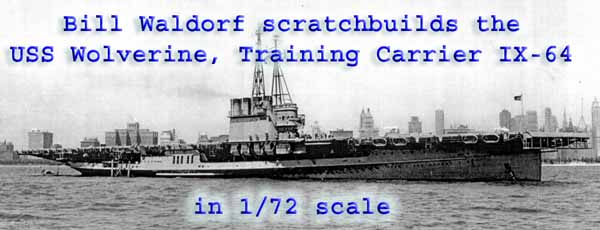 |
 |
| Hello again fellow Ship Modelers! Well, it's been a while since I have
done a build article so I thought it would be good time for a new subject
to show. This time it is the USS Wolverine, IX-64, which was a US
Navy Aircraft Carrier Training ship that was converted from a paddle wheeled,
coal fired excursion vessel that plied the great lakes in the 1900's, the
SS Seeandbee. The model is scratchbuilt in 1/72nd scale and took a little
over 11 months to build and contains about 4,000 individual pieces in all.
No, I didn't count them all but I gotta believe it somewhere around there!!
The Wolverine also had a sister, the USS Sable which was converted from
the steamer, SS Greater Buffalo after the Wolverine. The Navy acquired
the SS Seeandbee in 1942 for $750,000 and estimated that the conversion
to an aircraft carrier would take four months. The conversion actually
took 59 days!!
The conversion was begun in Cleveland with the removal of the five magnificent (mostly wood) upper decks with their contents of settees, davenports, bed springs, carpet, pillows, life jackets, basins, and bar stools, on april 14, 1942. The hull was then taken to the American Shipbuilding Company's yard at Buffalo, N.Y. Conversion involved constructing a massive flightdeck and surrounding catwalk. The flightdeck was a mere 26 feet above the waterline, less than half the height of conventional carriers, but it was 98 feet wide to cover the paddlewheels. This was wider than the fleet carrier USS Essex! There was no catapult, but there was a nine wire arrestor system and three barrier arm assemblies to keep planes from running off the deck into the chilly waters of Lake Michigan. There was no hanger deck or elevators. The main deck area included officers' quarters aft, wardroom, and crews quarters forward, as well as a motion picture equipped instruction room, a ship's service store, laundry, tailor shop, barber shop, dining rooms and crew's rec. room. There was also a full galley. A small "island" was constructed on the starboard side just forward of the wheel house to provide realistic flightdeck appearance. This structure housed the four funnels and limited command facilities. It also gave a "feel" to the flightdeck similar that of a fleet carrier. The object being to make training as real as possible. The Wolverine carried no armament or armor but did carry early types of air search radar. When the conversion was completed, the
Wolverine had the following specs:
Techniques and procedures learned from the conversion of the Wolverine were employed in the conversion of the Greater Buffalo. The most dramatic difference between the two ships was that the Wolverine was fitted with an Oak flightdeck in common with the fleet carriers of the time. The Greater Buffalo, which was renamed the USS Sable, had a flightdeck made of two designs of steel flightdecking topped with eight types of commercial non-skid coatings, applied in a checkerboard pattern. Sable was also heavier and a bit faster. Throughout the duration of the Second World War, The Wolverine and the Sable qualified more than 17,800 pilots for aircraft carrier operations, and that or more of deck crews. These two ships were the only fresh-water, paddle-wheeled, coal fired aircraft carriers in the history of the world. They were both scrapped in 1947. A sad end to two great ships. Let's move on to the build! |
